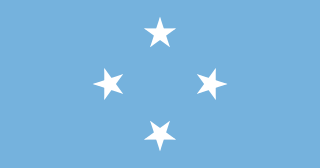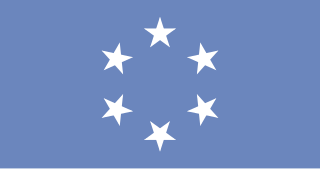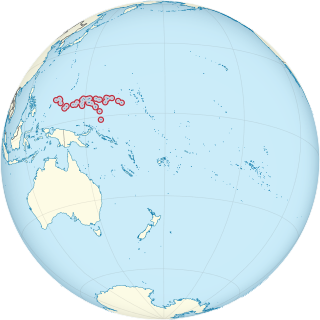Asia
East Asia
 Hong Kong
Hong Kong - Kai Tak Airport (terminated due to airport closure)
- Hong Kong International Airport
 Japan
Japan  South Korea
South Korea  Taiwan
Taiwan
This article is being considered for deletion in accordance with Wikipedia's deletion policy. Please share your thoughts on the matter at this article's deletion discussion page. |
Continental Micronesia flew to the following airports.
On December 22, 2010, Continental Micronesia's operating certificate was merged into Continental's, all Continental Micronesia flights became branded as Continental flights.

The Federated States of Micronesia, or simply Micronesia, is an island country in Micronesia subregion of Oceania. It consists of four states—from west to east, Yap, Chuuk, Pohnpei and Kosrae—that are spread across the western Pacific. Together, the states comprise around 607 islands that cover a longitudinal distance of almost 2,700 km (1,700 mi) just north of the equator. They lie northeast of Indonesia and Papua New Guinea, south of Guam and the Marianas, west of Nauru and the Marshall Islands, east of Palau and the Philippines, about 2,900 km (1,800 mi) north of eastern Australia, 3,400 km (2,100 mi) southeast of Japan, and some 4,000 km (2,485 mi) southwest of the main islands of the Hawaiian Islands.

Geography of the Federated States of Micronesia (FSM), a country located in the western Pacific Ocean, and in the Micronesia cultural and ecological sub-region of Oceania. While its total land area is very small at 702 km2 (271 sq mi), it has the 14th largest exclusive economic zone at 2,996,419 km2 (1,156,924 sq mi).

The Trust Territory of the Pacific Islands (TTPI) was a United Nations trust territory in Micronesia administered by the United States from 1947 to 1994. The Imperial Japanese South Seas Mandate had been seized by the US during the Pacific War. The Federated States of Micronesia, Marshall Islands and Palau are today independent states in a Compact of Free Association with the US. The Northern Mariana Islands remain under US jurisdiction, as an unincorporated territory and commonwealth.

The flag of the Federated States of Micronesia was adopted on 30 November 1978. The blue field represents the Pacific Ocean. In an echo of U.S. heraldic practice, the stars represent the four federated states: Chuuk, Pohnpei, Kosrae and Yap, arranged like the points of the compass.

This is a list of hospitals in Oceania for each sovereign state, associated states of New Zealand, and dependencies, and territories. Links to lists of hospitals in countries are used when there are more than a few hospitals in the country. Oceania has an area of 8,525,989 km2 and population of 41,570,842 (2018). The World Health Organization surveys of healthcare in smaller countries are used to identify hospitals in smaller countries.

The flag of the Trust Territory of the Pacific Islands (TTPI) consisted of a light blue field that contained six white stars centered in a circle pattern. The stars symbolized the six districts of the Trust Territory of the Pacific Islands: the Marianas, the Marshall Islands, Yap, Chuuk, Pohnpei, and Palau. The blue field symbolized freedom and loyalty.

Chuuk State is one of the four states of the Federated States of Micronesia (FSM). The other states are Kosrae State, Pohnpei State, and Yap State. It consists of several island groups: Namoneas, Faichuuk, the Hall Islands, Namonuito Atoll, Pattiw, and the Mortlock Islands. Chuuk is the FSM's most populous state, with 50,000 inhabitants on 120 square kilometers. Chuuk Lagoon is where most people live. Weno island, in the lagoon, is Chuuk's state capital and the country's biggest city. It may hold a referendum on independence in the near future, although this referendum has been repeatedly postponed.

Yap State, is one of the four states of the Federated States of Micronesia (FSM). The other states are Kosrae State, Pohnpei State, and Chuuk State.

The Micronesian imperial pigeon, also known as the Micronesian pigeon, and Belochel is a species of bird in the family Columbidae (doves). It is found in Palau, the Caroline Islands, the Marshall Islands and Nauru. Its habitats include montane forests, secondary forests, forests on beaches, and mangroves. It is threatened by hunting and deforestation, and the IUCN has assessed it as a near-threatened species.

The Micronesian myzomela is a species of bird in the honeyeater family Meliphagidae. The species forms a superspecies with a number of related and similar looking island and mainland myzomelas across the Pacific and Australasia. It in turn is composed of seven insular subspecies.
Athletics competitions at the 2014 Micronesian Games were held at the Pohnpei Track and Field in Palikir, Pohnpei, between July 21–24, 2014.
The Island Hopper is an airline route between Guam and Honolulu, Hawaii, via several small islands in the Federated States of Micronesia and the Marshall Islands. The route, currently operated by United and originally by Continental Micronesia, is the only scheduled service for many of the islands visited en route.
The Human Rights Measurement Initiative finds that the Federated States of Micronesia are fulfilling 94.9% of what it should be fulfilling for the right to health based on its level of income. When looking at the right to health with respect to children, the Federated States of Micronesia achieve 97.1% of what is expected based on their current income. In regards to the right to health amongst the adult population, the country achieves only 91.9% of what is expected based on the nation's level of income. The Federated States of Micronesia fall into the "good" category when evaluating the right to reproductive health because the nation is fulfilling only 95.8% of what the nation is expected to achieve based on the resources (income) it has available.

The Carolines tropical moist forests is a tropical and subtropical moist broadleaf forests ecoregion in Micronesia. It includes the central and eastern Caroline Islands in the Federated States of Micronesia.

The Church of Jesus Christ of Latter-day Saints in the Federated States of Micronesia refers to the Church of Jesus Christ of Latter-day Saints and its members in the Federated States of Micronesia (FSM). The church's first known missionaries arrived on July 5, 1978. As of December 31, 2022, there were 5,966 members in 23 congregations in FSM. The LDS Church has congregations in every state in the FSM.
Football competitions have were first held at the Micronesian Games for the 1998 edition of the tournament. The event is open to the ten member federations of the Micronesian Games Council, a sub-regional member of the Oceania National Olympic Committees. The football tournament has been held at two subsequent games since 1998, in 2014 and 2018. Although a similar football tournament called the Micronesian Cup was held in 1999 and 2001, they were separate events as no Micronesian Games were held in those years.

US Naval Base Carolines was number of United States Navy bases on the Caroline Islands in the western Pacific Ocean, to the north of New Guinea during World War II. The bases were built to support the island hoping Pacific war efforts of the allied nations fighting the Empire of Japan.